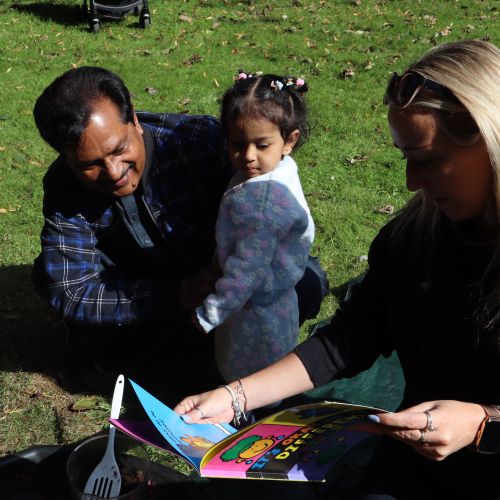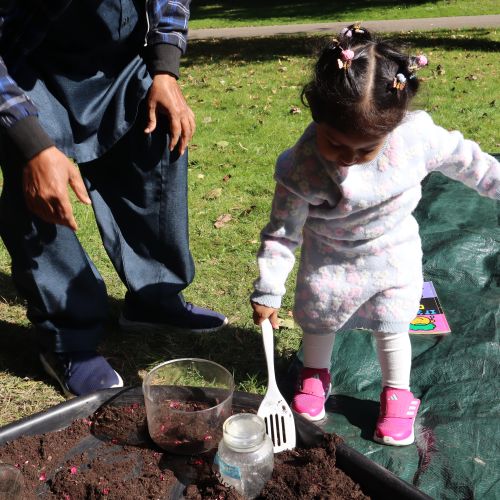Blog
Reflections on Leadership Outside
As a former early childhood teacher, headteacher, and as a parent and grandparent I have recently been considering aspects of leadership in relation to parent and grandparent roles. These often act as good parallels to the roles (and responsibilities) which the early years workforce has to fulfil in daily situations. In the centre are children. These children can also lead, if given the opportunities, choices, and situations to do so. But sometimes things get in the way……
The benefits outweigh the concerns:
It is now recognised that outdoors benefits us all, but particularly children with improved physical and mental health. The development and improvement of key skills such as problem-solving, interpersonal social skills such as listening, negotiating, co-ordinating, and concentration.
Through being outdoors children start to appreciate, value and understand nature and the world around them, particularly within their local community.
Outdoors is very open-ended and provides a great deal of nourishment for creativity and imagination. With less toys and formal equipment, things found in nature can become whatever a child wishes them to be e.g. fir cones can be stew in a saucepan, a stick becomes a fishing rod. Children’s brains are very fluid so the endless possibilities of outdoors stimulates their brains.
Outdoors allows children to try out things for themselves and test their prowess at certain challenges which they choose. They can experiment, explore and ‘try out’ different strengths, skills and ideas to become themselves as they choose rather than following adult-led objectives. Through testing their own boundaries they can challenge their bodies and minds, develop resilience and start to assess risks. Risky play is as important as food and sleep and evidence is emerging that the mental health crisis in teenagers is a result of them lacking outdoor opportunities in younger years.

Parent, child and practitioner

Outdoor playing
The brick wall:
The big but to all this is the adult ‘wall’ which prevents or restricts children playing and learning outdoors. Some of this is fear of accidents and the legal implications, and some comes from government-led increasingly formal curriculum developments. As pedagogical leaders we need to extend outdoor opportunities for the children alongside our duty of care. The balance between the two may vary with the uniqueness of each child so we need to find a happy medium of ‘reasonably’ challenging yet safe outdoor provision. However, if we do not allow children to try new things and develop skills at their unique pace alongside making their own mistakes, we are depriving them of important learning opportunities.
I often reflect on the wise words of climber Anna Fleming in Time on Rock, which has some lovely quotes about risk and failure:
“Risk is integral to being human.”
“Risk is intensely personal and subjective.”
“Risk takes you into the sphere of uncertainty, which can be a difficult space to inhabit. But fear of risk is paralysing. I have seen many people get stuck in difficult places (both on and off the rock) because they are afraid to take a chance.”
Anna stresses how much can be learnt from fear and failure. I believe that we have become over-protective of our children and grandchildren, and that this often prevents them living life to the fullest.
For the outdoor adult responsible for leading children, the challenges are different and less predictable than indoors. Hazards and potential risks abound, and if one focuses on them too much the result is paralysis. Factors such as seasons, weather, topology, environment and community add real depth to careful considerations when considering individual child development and unique needs.
The qualities of outdoor leaders include:
• Confidence: being at ease with materials, resources, plants, wildlife, all weathers and all seasons and being able to appropriately assess risk, benefits and challenges.
• Enthusiasm: being prepared and equipped with suitable clothing and footwear so you appear keen to be outdoors and can maximize possibilities.
• Knowledge, understanding and skills: using apps and simple guides to help you identify and become familiar with the plants, insects, birds, mammals and other animals you are likely to come across outside. You can also demonstrate being a learner through their use.
• Experience: taking time to develop confidence. Reading, collaborating, attending courses and observing best practices to build your own experience, and then sharing what you’ve learned. Valuing contributions from colleagues, parents and children too.
Showing by Doing is central to the official leader in a setting or school, as outdoors can present particular challenges. Ultimately, we need to reflect upon what kind of learning and play we wish to offer and what kind of children may result from our vision.
-
Be consistent. You cannot expect staff to buy into your vision if you don’t follow its basic principles yourself. If you want staff to have high expectations for all, inside and out, you need to demonstrate this through what you say and do, inside and out and in every decision, big or small, that you make. If you want staff to advance their learning, then you have to give them time and resources to do so, while ensuring you advance your own learning, too.
-
Model good practice. My chosen title was ‘head learner’, and one of the most significant ways in which I led and motivated staff was by teaching most days in a variety of ways. I firmly believe that as leaders and managers of settings, we should be modelling teaching and learning, outdoors and inside.
-
Good leaders lead by providing an example of learning. If that example is poor, then eventually the experience of staff and children will be similar.
What Children Need
What we provide outdoors should be based upon the children and what they need to learn in developmentally appropriate ways. Thus, we need to observe the children for the ‘clues’ to possible lines of development so that potential experiences can be placed in the environment to support that phase of development. Ultimately the only way that children can grow up is through experiences. If those experiences are as safe as necessary but not over-protected in cotton wool, they will rise to challenges appropriately and learn to keep themselves safe.
What Adults Need
Your staff team will vary considerably in their personal experiences of the world outside. Some will always prefer indoors, but many will follow a sensitive lead and support, with the provision of appropriate clothing and footwear, and will gradually start to explore and enjoy some of the possibilities. Good starters are a nature table, growing potatoes and other vegetables, mini-beast hunts and feeding the birds. A small-steps approach and lots of encouragement and praise are essential.
Adding Value
Never forget the possibilities of the community around you. You can plan a range of experiences that will secure and extend children’s learning in meaningful ways. I prefer to call these opportunities ‘expeditions’ as they need careful planning and pre-visiting to ensure safe and successful completion.
First understand each child’s needs, interests and dispositions, then the natural world and local community can provide vast opportunities to discover, examine and explore further. Bringing in supervised visitors to your setting can also bring huge benefits, as such folk can be excellent interactive role-models of skills, talents, hobbies and interests. The cross-curricular gains are enormous and each child will benefit in different ways. Involving parents and carers will also add to the depth of understanding and help to reduce anxiety. The experience can also give them ideas of opportunities they can take to widen their child’s world outside of formal education.
Start simply with a locality walk and gradually build up to joint learning adventures on public transport to museums, galleries, parks, rivers, lakes, gardens and places of interest locally. Other opportunities can come from shops, banks, markets, etc. The learning will involve and affect all those taking part in the adventure, whether adult or child, as the environment visited acts as a catalyst for new challenges and opportunities to ‘struggle’ (pedagogically speaking).
Expeditions teach so much about challenge, adaptation, problem solving and communication. They also help to keep children as safe as necessary by being out in the world around them.
To quote Aldo Leopold: “Land is not merely soil, it is a fountain of energy flowing through a circuit of soils, plants and animals.”
Our land is fascinating and it is part of us and we are part of it. Our species has evolved as part of the landscape around us, so we owe it to our children to take them outside to explore, learn, relish and be challenged by it.
Tips
• Sharing your vision is a great starting point
• Value contributions
• Involve the team’s ideas in your development plans
• The children are the driver
• Enthusiasm is infectious
• Strong and purposeful leadership develops a strong culture outdoors over time
• Be creative
• Provide some funding to support development, if at all possible
• Don’t see yourself as an ‘expert’
• Access and invest accredited training
• Visit other schools and settings
• If you are not the head teacher or manager, ensure you have their involvement and commitment
• Just do it!
Tips for New Outdoor Leaders
• Have confidence in yourself.
• Connect with those around you; help is often free.
• Don’t get caught up in micromanaging; take a step back and observe.
• Accept that we all make mistakes.
• Celebrate achievements, however small.
• Innovate very slowly.
References:
Fleming, A., (2003). Time on rock. Cannongate Books, Edinburgh UK.
Leopold, A., (1989). A sand county almanac, and sketches here and there. Oxford University Press, USA.
 |
Kathryn Solly Early Education Associate
|
